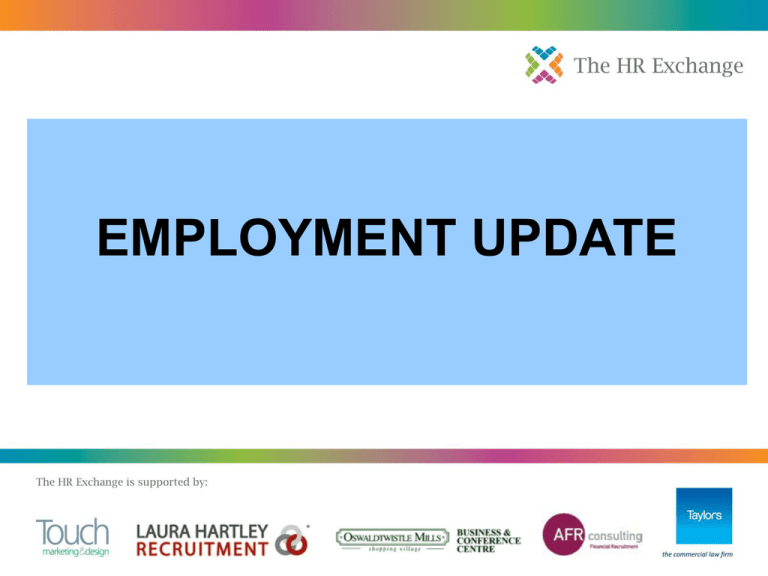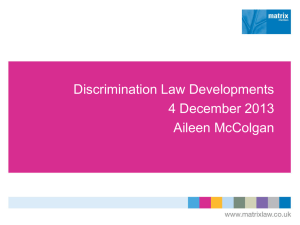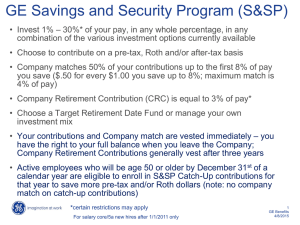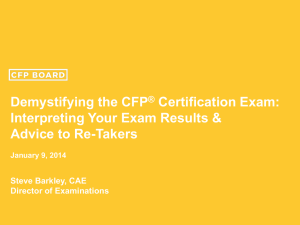
EMPLOYMENT UPDATE
1. RETIREMENT UPDATE
DRA 65 to be abolished (consultation closed)
Still retire staff whose 65th birthday falls before 30.09.11
Must still follow statutory retirement procedure to avoid
claims
Retirement procedure to be abolished 06.04.11
Transitional arrangements apply to retirements already in
motion where retirement notification already given,
retirement before 1 Oct and statutory requirements met
Expected that “retirement” to be removed as fair reason
for dismissal (s98 ERA 1996)
2. WHAT NEXT?
Retain a retirement age
1. What do you set as CRA?
2. Can you objectively justify act of age discrimination?
- s13 – direct discrimination due to protected characteristic
- s13(2) – carve out to allow OJ of direct age
discrimination (unique)
- s19 – indirect discrimination (PCP)
- proportionate means of achieving a legitimate aim
- “employer justified retirement age”
3. Can you also demonstrate fair reason for dismissal
and fair process?
3. WHAT NEXT?
Proceed without a defined retirement age
Deal with retirement on case by case basis OR
Dismiss for other reasons, eg. capability, poor
performance, improve voluntary retirement
process
Government expected to publish Code of Practice
on retirement dismissals and guidance for
employer on managing without a retirement age
4. RELEVANT RETIREMENT CASES
Seldon v. Clarkson Wright and Jakes (BIS intervening)
(CA 2010)
Rosenblat v. Ollerking Gebaudereiningunsges GmbH
(ECJ 2010)
Best Practice:
1. Timetable retirement dismissals before 01.10.11
2. Make business decision on what to put in place
06.04.11
[continued …]
RELEVANT RETIREMENT CASES [cont]
3. Any CRA needs to be OJ – gather as much
information, data and reasoning as possible to justify
CRA – consult with TUs and workforce (critical)
4. CRA – agree with workforce/TUs a fair retirement
process
5. Look to introduce or amend voluntary retirement
schemes
5. EQUALITY ACT 2010
Protected characteristics (“PC”) = age, disability,
gender reassignment, marriage and civil partnership,
pregnancy and maternity, race, religion or belief, sex,
sexual orientation
Gender reassignment – no need to be under medical
supervision now
Direct discrimination (s13) – definition wide enough to
cover discrimination on grounds of perception or
association (“because of a PC”)
[continued …]
EQUALITY ACT 2010 [cont ...]
Indirect discrimination – definition such that concept
limited to those with a PC (does not extend to
association)
Harassment (s26) – “unwanted conduct related to a
particular characteristic” – wide enough to cover
harassment due to “association” to a person with PC or
perceived PC
Harassment by third parties (s40) – employer liable for
persistent harassment of employee by third parties
(covers all PC, before was just sex) – [continued …]
EQUALITY ACT 2010 [cont ...]
knowledge of harassment, in course of employment,
on at least two occasions, no reasonable practicable
steps to prevent
Pre-employment health questionnaires – unlawful until
offer stage, save for exceptions
Secrecy clauses – unenforceable where there is
relevant pay disclosure
Compromise agreements?
Positive action and pay transparency - suspended
EQUALITY ACT 2010 [cont ...]
Best Practice:
(Statutory defence s109 – “reasonable steps to
prevent”): amend existing EOP/harassment policy,
updated examples/definitions
Policy on third party harassment and duty on employee
to notify company
Distribute revised policies and obtain signatures – “read,
understood and agree to abide by”
Refresher training across business
Signs in workplace regarding harassment towards staff
6. DATE OF DISMISSAL
Gisda Cyf v. Barratt (S/C 2010)
EDT date read letter, not date sent or arrived at home
address
Best Practice:
Communicate dismissal decision verbally wherever
possible and confirm in writing
Where making decision in letter and not communicating
verbally, arrange personal delivery where possible.
7. INFORMATION AND CONSULTATION
TUPE 2006 and TULR(C)A 1992
Todd v. Strain (EAT 2010) – “measures”
Todd v. Care Concern (EAT 2010) – protective award
(amount and joint liability)
USA v. Nolan (CA 2010) – when does consultation begin?
Lancaster University v. The University and College Union –
protective award
Best Practice:
Measures can include administrative changes
[cont …]
INFORMATION AND CONSULTATION [cont]
I&C should always be undertaken – some I&C better
than none at all
Obtain indemnities and warranties in any business
sale agreement
Remember winning a contract/tender may be a
service provision change
8. DISCRIMINATION AND JUSTIFICATION
Woodcock v. Cumbria Primary Care NHS Trust (EAT
2010)
Cost and justification defence
Best Practice:
Cost alone may now be a reason to justify discrimination
contrary to previous authorities – take legal advice though!
Must be where the cost of avoiding or rectifying
discrimination is disproportionately high
9. REFUSAL OF RE-ENGAGEMENT AND
MITIGATION
Bloxwich Fencing v. Banks (EAT 2010)
Employee’s refusal of re-engagement was not a failure to
mitigate
Best Practice:
Demonstrates importance of meaningful consultation in lead up
to termination and re-engagement on new terms
Important to avoid breach of implied terms of trust and mutual
confidence arising from manner in which dismiss and offer reengagement
10. REASON DISMISSAL
Celebi v. Compass Group (EAT 2010)
Dismissal for theft
Allegation “loss of £3,000”
Unfair dismissal due to lack of precision
Best Practice:
State clearly allegation you are making
Ideally link allegation to examples set out in disciplinary
policies or procedures
Identify whether allegation is of gross misconduct which
could result in summary dismissal, or misconduct
11. RESTRUCTURING/REDUNDANCY
CIBC v. Beck (EAT 2010)
Restructuring, no redundancy
S139: “requirements for business for employees to carry
out work of a particular kind have ceased or diminished”
Best Practice:
Before commence any consultation process, need to
critically analyse roles under new structure with those
under old structure to determine if fall within s139
Differences in roles need to be material and actual
12. SPIRITUALIST BELIEFS
Power v. GMP (EAT 2010)
Dismissed because of way he promoted his spiritualist
beliefs at work
Lawfully discipline employees where inappropriately
manifest protected beliefs in workplace
Best Practice:
Identify distinction between treatment on grounds of a
person’s belief and treatment on the ground of the
manifestation of those beliefs
Consider updating EOP
Taylors Solicitors
Employment Team
Oliver McCann – Elaine Hurn – James Bellamy
Rawlings House
Exchange Street
BLACKBURN
BB1 7JN
Ninth Floor
80 Mosley Street
MANCHESTER
M2 3FX
Tel: 0844 8000 263
www.taylors.com










